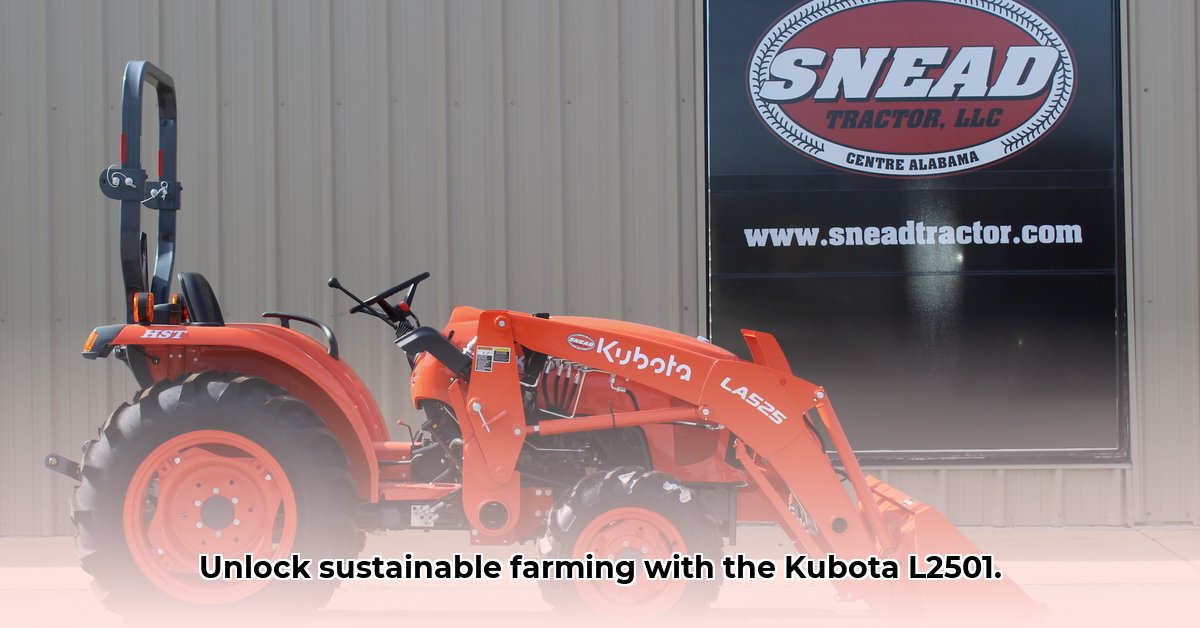
Kubota L2501: A Compact Tractor for Sustainable Farming?
Considering the Kubota L2501 for your farm? This guide provides a comprehensive review and practical advice to help you decide if this compact tractor aligns with your sustainable farming goals. We'll examine its strengths and weaknesses, compare it to newer models, and offer guidance on purchasing and maintenance. For more Kubota tractor information, see this helpful Kubota resource.
Maneuverability and Power: The L2501's Strengths
The Kubota L2501 shines in maneuverability. Its compact design excels in tight spaces, making it ideal for navigating obstacles and working in confined areas like orchards or vineyards. Its 24.8 horsepower engine (a significant amount of power for its size) handles a wide range of tasks, from tilling to hauling. The availability of both 2-wheel drive (2WD) and 4-wheel drive (4WD) models offers flexibility for various terrains. Isn't ease of use in challenging environments a crucial aspect of efficient farming?
Limitations and Considerations: Fuel Efficiency and Technology
The L2501, being an older model, utilizes an open-center hydraulic system. While reliable, this system is less efficient than the closed-center systems found in newer tractors, potentially leading to higher fuel consumption and less precise implement control. This is an important factor to consider, especially for environmentally conscious farmers focusing on minimizing their carbon footprint. Furthermore, integrating modern precision agriculture technologies like GPS guidance can be challenging. The PTO (power take-off) power, while adequate for many tasks, may limit the use of larger or more demanding implements. Does your farming operation require the use of high-power attachments?
Making an Informed Decision: Key Factors for Purchasing a Used L2501
Before purchasing a used Kubota L2501, meticulous planning is essential.
Maintenance and Repair Costs: Older tractors require more frequent maintenance and are more prone to repairs. Budget for these potential costs. Are you prepared for unexpected expenses? Do you possess the mechanical skills to handle repairs independently or have access to reliable mechanics?
Parts Availability: Confirm the availability of parts in your region. A strong relationship with a local Kubota dealer is beneficial for timely part acquisition.
Fuel Efficiency: While precise fuel consumption data for the L2501 might be difficult to obtain, note that newer models offer significantly better fuel efficiency, impacting long-term operating costs. Will the lower initial cost outweigh the increased fuel expenditure?
Technology Integration: If precision agriculture and advanced technology are priorities for sustainable farming, the L2501's technological limitations might be a significant drawback. Will this limit your ability to optimize farming practices and yields over time?
Sustainability Considerations: Balancing Economic and Environmental Goals
Sustainability in farming involves balancing economic viability with environmental stewardship. The Kubota L2501's smaller size and lower horsepower requirements, compared to larger tractors, can translate to lower fuel consumption and a reduced carbon footprint for lighter tasks. However, its lower fuel efficiency compared to newer models requires careful consideration. A newer, more fuel-efficient tractor, although more expensive upfront, might prove more economically and environmentally sustainable in the long run due to reduced operational costs.
Actionable Steps: Guiding Your Purchasing Decision
Thorough Research: Research extensively, comparing the L2501 with similar, newer models. Analyze specifications meticulously.
Total Cost of Ownership: Calculate the total cost of ownership, encompassing fuel, maintenance, repairs, and potential upgrades.
Needs Assessment: Honestly assess your farm's operational needs. Will the L2501's capabilities meet your short-term and long-term objectives?
Weighing the Pros and Cons: A Practical Summary
| Pros | Cons |
|---|---|
| Compact size and maneuverability | Older technology; limited precision agriculture capabilities |
| Potentially lower initial purchase price (used) | Higher maintenance and repair costs likely |
| Suitable for smaller farms and various tasks | Lower fuel efficiency compared to newer models |
| Simpler design, potentially easier maintenance | Less technologically advanced |
The Kubota L2501 presents a viable option for certain operations but requires thorough deliberation. Remember, sustainable farming is a balance; careful evaluation is key to a thriving and environmentally responsible operation.
Fuel Efficiency Comparison: Kubota L2501 vs. Newer Models
Fuel efficiency is paramount in modern agriculture, impacting both profitability and environmental responsibility. This section compares the Kubota L2501's fuel consumption to newer compact tractors.
Understanding Fuel Consumption Factors
Engine type, usage intensity, operator skill and even the type of work performed heavily influence fuel consumption in compact tractors. Newer models often incorporate advanced engine management systems and efficient hydraulics, leading to lower fuel use.
Comparative Analysis
The Kubota L2501, while reliable, is less fuel-efficient than contemporary models. Newer tractors utilize advanced engine technologies (e.g., improved fuel injection systems and electronic controls) and efficient hydraulic systems (e.g., load-sensing systems) which significantly reduce fuel consumption. Consider the transmission type, too – hydrostatic transmissions (HST) can be more fuel-efficient than geared transmissions in certain applications. Finally, always match the tractor's size and horsepower to your needs to avoid wasting fuel.
Comparing Fuel Consumption Data
Manufacturer Specifications: Consult manufacturer data for fuel consumption rates (gallons/hour or liters/hour) under various operating loads.
Real-World Testing: If feasible, conduct real-world tests under conditions simulating your actual operations.
Online Reviews: Review online resources and forums to gather independent fuel consumption accounts.
Total Cost of Ownership: Evaluate the total cost, including initial price, fuel, maintenance, and repair expenses.
Newer Compact Tractors vs. Kubota L2501: A Comparative Overview
| Feature | Newer Compact Tractors | Kubota L2501 |
|---|---|---|
| Fuel Efficiency | Generally superior due to technological advancements | Good for its time, but likely less efficient |
| Technology | Advanced features, including electronic controls | Simpler design |
| Cost | Higher initial investment | Lower initial purchase price |
| Comfort | Typically enhanced operator comfort | More basic comfort |
Key takeaways: Fuel efficiency is crucial; newer models offer technological advantages. Thorough comparison requires considering numerous factors; real-world testing is beneficial and calculating total cost of ownership is paramount.